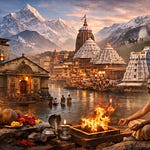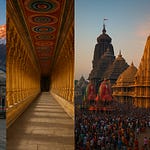India, often described as the cradle of ancient civilizations and religions, is adorned with a vast and diverse tapestry of sacred sites. From towering Hindu temples and serene Buddhist monasteries to revered Sikh gurdwaras and intricately carved Jain temples, these structures are not only centers of faith but also beacons of art, culture, and history. Millions of pilgrims and tourists visit these sites every year, drawn by both spirituality and heritage.
Hindu Temples: The Spiritual Backbone of India
India is home to a staggering number of Hindu temples, with 6,48,907 documented temples spread across the country. However, scholars and historians estimate the actual number to be closer to 750,000, as many smaller or remote temples may remain undocumented. The distribution of these temples varies significantly, with southern and western India having a particularly high density of sacred structures.
Top 10 States with the Highest Number of Hindu Temples
Tamil Nadu – 79,154 temples
Maharashtra – 77,283 temples
Karnataka – 61,232 temples
West Bengal – 53,658 temples
Gujarat – 49,995 temples
Andhra Pradesh – 47,152 temples
Rajasthan – 39,392 temples
Uttar Pradesh – 37,518 temples
Odisha – 30,877 temples
Bihar – 29,748 temples
Prominent Hindu Temples
Tamil Nadu: Known as the “Land of Temples,” it boasts iconic structures like the Meenakshi Amman Temple in Madurai and the Brihadeeswarar Temple in Thanjavur.
Andhra Pradesh: The Tirumala Venkateswara Temple in Tirupati ranks among the world’s most visited pilgrimage destinations.
Uttarakhand: Nestled in the Himalayas, the Char Dham pilgrimage circuit—Badrinath, Kedarnath, Gangotri, and Yamunotri—draws devotees year after year.
Odisha: The majestic Jagannath Temple in Puri and the UNESCO-listed Sun Temple in Konark stand as testaments to Odisha’s architectural brilliance.
Madhya Pradesh: Home to sacred Jyotirlingas like Mahakaleshwar and Omkareshwar, as well as the stunning Khajuraho temples, renowned worldwide for their intricate carvings.
Sikh Temples (Gurdwaras): Anchors of Service and Devotion
Sikhism, founded in Punjab in the 15th century, is deeply rooted in spiritual equality and community service. Across India, there are 8,528 gurdwaras, which serve as centers of devotion, learning, and humanitarian service. Not surprisingly, Punjab, the birthplace of Sikhism, hosts the highest number of these revered shrines.
Top States by Number of Gurdwaras
Punjab – 2,177 gurdwaras
Haryana – 1,020 gurdwaras
Uttar Pradesh – 954 gurdwaras
Maharashtra – 624 gurdwaras
Madhya Pradesh – 444 gurdwaras
Major Gurdwaras
Harmandir Sahib (Golden Temple), Amritsar – The holiest shrine in Sikhism, symbolizing peace and spiritual unity.
Takht Sri Patna Sahib, Bihar – Birthplace of Guru Gobind Singh, the tenth Sikh Guru.
Gurudwara Bangla Sahib, Delhi – Known for its sacred sarovar (holy water tank) and charitable kitchens.
Takhat Sachkhand Sri Hazur Sahib, Nanded (Maharashtra) – The place where Guru Gobind Singh attained joti jot (spiritual union).
Jain Temples: Marvels of Intricacy and Serenity
While an exact nationwide count of Jain temples is not readily available, their presence is especially strong in Maharashtra, Rajasthan, and Gujarat, where the Jain population is concentrated. Known as derasars or basadis, these temples are celebrated for their elegance, symmetry, and detailed artistry.
Notable Jain Sites
Palitana, Gujarat – A unique temple city with over 838 temples situated on the sacred Shatrunjaya Hill.
Shravanabelagola, Karnataka – Famous for the colossal monolithic statue of Gommateshwara (Bahubali), a symbol of non-violence and renunciation.
Dilwara Temples, Rajasthan – A complex of five temples on Mount Abu, famed for their exquisite marble carvings.
Shri Sammed Shikharji, Jharkhand – One of the most sacred pilgrimage destinations for Jains worldwide.
Ranakpur Temple, Rajasthan – A magnificent structure dedicated to Tirthankara Adinatha, blending grandeur with serenity.
Buddhist Temples and Monasteries: Echoes of Enlightenment
India, the birthplace of Buddhism, continues to house some of the most revered Buddhist temples and monasteries. While a definitive count is unavailable, their presence remains strong in Bihar, Uttar Pradesh, Madhya Pradesh, and the Himalayan belt.
Key Buddhist Centers
Bodh Gaya, Bihar – The site of Buddha’s enlightenment under the Bodhi tree, home to the Mahabodhi Temple Complex, a UNESCO World Heritage Site.
Sarnath, Uttar Pradesh – Where the Buddha delivered his first sermon, now a vital center of Buddhist learning.
Sanchi, Madhya Pradesh – Famous for its Great Stupa, one of the oldest stone structures in India.
Tawang Monastery, Arunachal Pradesh – The largest monastery in India and a major hub of Tibetan Buddhism.
Ajanta & Ellora Caves, Maharashtra – UNESCO-listed rock-cut cave complexes showcasing stunning Buddhist frescoes and sculptures.
Ladakh – Home to iconic monasteries like Hemis, Thiksey, and Diskit, which stand as spiritual strongholds in the Himalayas.
India’s sacred architecture forms a living mosaic of its spiritual and cultural identity. Hindu temples, Sikh gurdwaras, Jain derasars, and Buddhist monasteries each tell stories that transcend religion - stories of faith, resilience, artistry, and community. From the grandeur of Tirupati to the peaceful courtyards of Buddhist monasteries in Ladakh, these places embody India’s timeless role as a spiritual lighthouse for the world.











